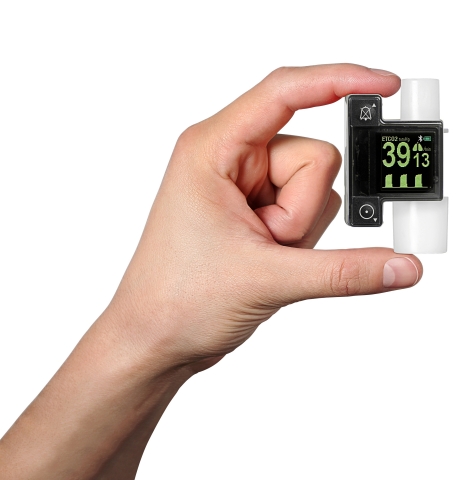New Study Evaluates the Feasibility of Using Masimo EMMA® Capnography on Mechanically Ventilated Neonates
Masimo (NASDAQ: MASI) announced a study published in the European Journal of Pediatrics, highlighting the effectiveness of its EMMA® Portable Capnograph for monitoring mechanically ventilated preterm infants. Conducted by Dr. Masashi Hotta and colleagues in Japan, the study involved 40 neonates and found that 80% in the EMMA group maintained appropriate carbon dioxide levels compared to 42% in a control group. The research emphasizes EMMA's potential in neonatal care, although it currently lacks FDA clearance for neonates.
- Study indicates EMMA may enhance patient monitoring for preterm infants, with 80% achieving appropriate PaCO2 levels.
- Significantly higher PaCO2 maintenance rate observed in larger infants using EMMA (93% vs. 44%).
- Study provides prospective intervention data, showing feasibility of a portable capnometer in a clinical setting.
- EMMA is not FDA cleared for use with neonates.

Masimo EMMA® (Photo: Business Wire)
Noting the importance of maintaining an appropriate range of partial pressure of arterial carbon dioxide (PaCO2) in preterm infants, especially while undergoing mechanical ventilation in the neonatal intensive care unit (NICU), the researchers sought to evaluate whether noninvasively monitoring end-tidal carbon dioxide (EtCO2) with EMMA could help clinicians maintain neonatal PaCO2 in the delivery room. They chose EMMA not only because of its portability but because it offers a solution with a small dead space (1 mL). The researchers enrolled 40 neonates (gestational age of 26+0 to 31+6 weeks) who required intubation in the delivery room (the EMMA monitoring group) and compared their PaCO2 value, either at admission to the NICU or 2 hours after birth, with that of 43 infants who did not undergo EMMA monitoring (the historical control group). They defined “appropriate” PaCO2 as 35 – 60 mmHg, as measured using a blood gas analyzer.
The researchers found that the proportion of infants with appropriate PaCO2 was greater in the EMMA group than in the control group (
The study authors concluded that EMMA “facilitated the maintenance of an appropriate PaCO2 for mechanically ventilated pre-term infants, especially infants with birth weight ≥ 1000 g, in the delivery room.” They noted that the main strength of their study was that they “collected intervention data prospectively and showed the feasibility of using a portable capnometer during resuscitation of intubated preterm infants” – the first study of its kind.
EMMA provides seamless mainstream capnography for patients of all ages in a compact, easily portable device. The instrument requires no routine calibration and minimal warm-up time, with accurate EtCO2 and respiration rate measurements and continuous EtCO2 waveforms displayed within 15 seconds.
EMMA does not have FDA clearance for neonates.
@Masimo | #Masimo
About Masimo
ORi and RPVi have not received FDA 510(k) clearance and are not available for sale in
References
- Hotta M, Hirata K, Nozaki M, Mochizuki N, Hirano S, and Wada K. Feasibility of portable capnometer for mechanically ventilated preterm infants in the delivery room. Eur J Ped. 2021. DOI:10.1007/s00431-021-04246-1.
- Published clinical studies on pulse oximetry and the benefits of Masimo SET® can be found on our website at http://www.masimo.com. Comparative studies include independent and objective studies which are comprised of abstracts presented at scientific meetings and peer-reviewed journal articles.
- Castillo A et al. Prevention of Retinopathy of Prematurity in Preterm Infants through Changes in Clinical Practice and SpO2 Technology. Acta Paediatr. 2011 Feb;100(2):188-92.
- de-Wahl Granelli A et al. Impact of pulse oximetry screening on the detection of duct dependent congenital heart disease: a Swedish prospective screening study in 39,821 newborns. BMJ. 2009;Jan 8;338.
- Taenzer A et al. Impact of pulse oximetry surveillance on rescue events and intensive care unit transfers: a before-and-after concurrence study. Anesthesiology. 2010:112(2):282-287.
- Taenzer A et al. Postoperative Monitoring – The Dartmouth Experience. Anesthesia Patient Safety Foundation Newsletter. Spring-Summer 2012.
-
McGrath S et al. Surveillance Monitoring Management for General Care Units: Strategy, Design, and Implementation.
The Joint Commission Journal on Quality and Patient Safety . 2016 Jul;42(7):293-302. - McGrath S et al. Inpatient Respiratory Arrest Associated With Sedative and Analgesic Medications: Impact of Continuous Monitoring on Patient Mortality and Severe Morbidity. J Patient Saf. 2020 14 Mar. DOI: 10.1097/PTS.0000000000000696.
- Estimate: Masimo data on file.
- http://health.usnews.com/health-care/best-hospitals/articles/best-hospitals-honor-roll-and-overview.
Forward-Looking Statements
This press release includes forward-looking statements as defined in Section 27A of the Securities Act of 1933 and Section 21E of the Securities Exchange Act of 1934, in connection with the Private Securities Litigation Reform Act of 1995. These forward-looking statements include, among others, statements regarding the potential effectiveness of EMMA®. These forward-looking statements are based on current expectations about future events affecting us and are subject to risks and uncertainties, all of which are difficult to predict and many of which are beyond our control and could cause our actual results to differ materially and adversely from those expressed in our forward-looking statements as a result of various risk factors, including, but not limited to: risks related to our assumptions regarding the repeatability of clinical results; risks related to our belief that Masimo's unique noninvasive measurement technologies, including EMMA, contribute to positive clinical outcomes and patient safety; risks related to our belief that Masimo noninvasive medical breakthroughs provide cost-effective solutions and unique advantages; risks related to COVID-19; as well as other factors discussed in the "Risk Factors" section of our most recent reports filed with the
View source version on businesswire.com: https://www.businesswire.com/news/home/20210926005040/en/
Masimo
949-396-3376
elamb@masimo.com
Source: Masimo
FAQ
What are the findings of the recent Masimo study published in the European Journal of Pediatrics?
What is the significance of the EMMA Portable Capnograph in neonatal care?
Is the Masimo EMMA Portable Capnograph FDA cleared for use in neonates?
How effective was the EMMA device in maintaining appropriate carbon dioxide levels in the study?







